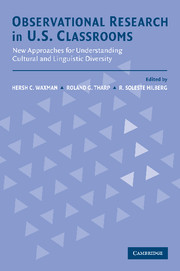 Observational Research in U.S. Classrooms
Observational Research in U.S. Classrooms Book contents
- Frontmatter
- Contents
- Tables, Figures, and Appendixes
- Contributors
- 1 Introduction: Purposes and Perspectives on Classroom Observation Research
- 2 Using Multiple Perspectives in Observations of Diverse Classrooms: The Sheltered Instruction Observation Protocol (SIPO)
- 3 The Standards Performance Continuum: A Performance-Based Measure of the Standards for Effective Pedagogy
- 4 The Uses of the Classroom Observation Schedule to Improve Classroom Instruction
- 5 Development and Use of a Classroom Observation Instrument to Investigate Teaching for Meaning in Diverse Classrooms
- 6 Patterns of Language Arts Instructional Activity and Excellence in First– and Fourth–Grade Culturally and Linguistically Diverse Classrooms
- 7 Using Classroom Observation as a Research and Formative Evaluation Tool in Educational Reform: The School Observation Measure
- 8 Observing School Restructuring in Multilingual, Multicultural Classrooms: Balancing Ethnographic and Evaluative Approaches
- 9 Sociocultural Activity Settings in the Classroom: A Study of a Classroom Observation System
- 10 The Influence of School Reform on Classroom Instruction in Diverse Schools: Findings from an Observational Study of Success for All
- 11 Future Directions for Classroom Observation Research
- Index
- References
11 - Future Directions for Classroom Observation Research
Published online by Cambridge University Press: 23 November 2009
- Frontmatter
- Contents
- Tables, Figures, and Appendixes
- Contributors
- 1 Introduction: Purposes and Perspectives on Classroom Observation Research
- 2 Using Multiple Perspectives in Observations of Diverse Classrooms: The Sheltered Instruction Observation Protocol (SIPO)
- 3 The Standards Performance Continuum: A Performance-Based Measure of the Standards for Effective Pedagogy
- 4 The Uses of the Classroom Observation Schedule to Improve Classroom Instruction
- 5 Development and Use of a Classroom Observation Instrument to Investigate Teaching for Meaning in Diverse Classrooms
- 6 Patterns of Language Arts Instructional Activity and Excellence in First– and Fourth–Grade Culturally and Linguistically Diverse Classrooms
- 7 Using Classroom Observation as a Research and Formative Evaluation Tool in Educational Reform: The School Observation Measure
- 8 Observing School Restructuring in Multilingual, Multicultural Classrooms: Balancing Ethnographic and Evaluative Approaches
- 9 Sociocultural Activity Settings in the Classroom: A Study of a Classroom Observation System
- 10 The Influence of School Reform on Classroom Instruction in Diverse Schools: Findings from an Observational Study of Success for All
- 11 Future Directions for Classroom Observation Research
- Index
- References
Summary
This chapter summarizes the work presented in the book, reviews some of the ways classroom observation has contributed to the research knowledge in the field of teacher effectiveness, and discusses some of the important implications of the book for the improvement of teaching and student learning in culturally diverse settings. Some of the criticisms and cautions related to the use of structured observation and techniques are also summarized. Finally, some future directions for observational research are reported and three specific views are described: (a) using instruments that reflect best practices or educational standards, (b) instruments that focus on student behaviors as well as teachers, and (c) combining qualitative and quantitative methods in observation instruments.
LIMITATIONS OF SYSTEMATIC CLASSROOM OBSERVATION
Although previous chapters have highlighted some of the important purposes of classroom observation, there have also been several criticisms and cautions related to the use of structured observation techniques (Delamont & Hamilton, 1986; Evertson & Green, 1986; Galton, 1988; McIntyre & Macleod, 1986). The criticisms and limitations of using structured observation techniques are categorized into three subsections: (a) Theoretical and Epistemological Criticisms, (b) Methodological Concerns, and (c) Pragmatic Concerns. This section also includes a brief discussion of the implications of classroom observation and some future directions.
Theoretical and Epistemological Criticisms
Although observational research has produced a substantial body of important findings that can lead to improved teaching practices, there is still a lack of consensus or lack of confidence regarding the research (Nuthall & Alton-Lee, 1990).
- Type
- Chapter
- Information
- Observational Research in U.S. ClassroomsNew Approaches for Understanding Cultural and Linguistic Diversity, pp. 266 - 278Publisher: Cambridge University PressPrint publication year: 2004
References
- 5
- Cited by
